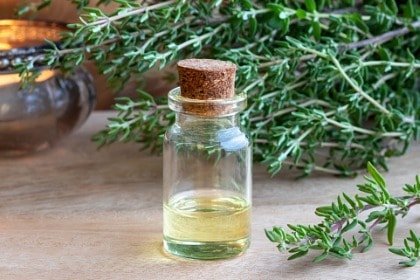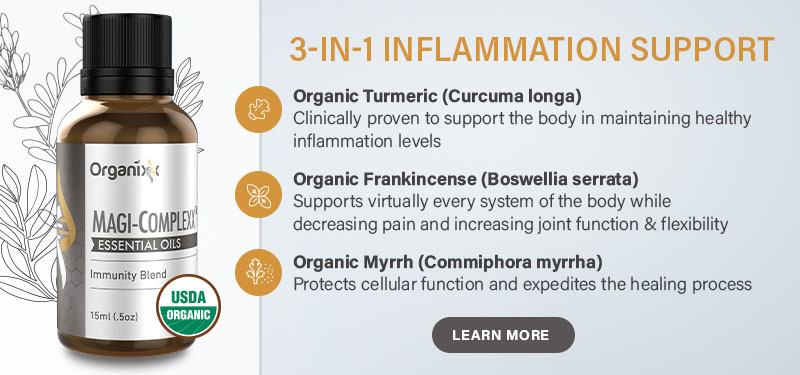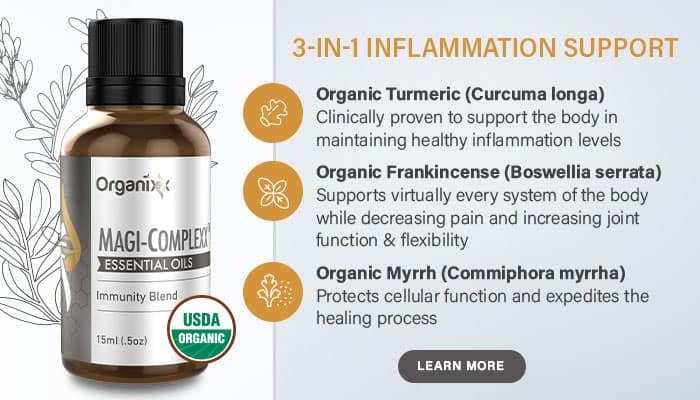One of the best things about combining essential oils is that the different oils work together in a synergetic way. In other words, as amazing as individual oils are, they often work even more powerfully in combination.
In addition to individual essential oils, Organixx used to carry an immunity essential oil blend called Shield. Even though Organixx no longer carries the line of EO blends (except for Magi-Complexx), you may still have some Shield Essential Oil blend on hand.
Organixx Shield Essential Oil Blend was created to:
- protect against and eradicate some of the most common germs and bacteria we come into contact with.
- help to promote the body’s innate healing abilities and to boost the function of the immune system.
How to Create Your Own Immunity Oil Blend
Organixx Shield was a blend made from five essential oils that each have potent healing properties:
Sounds good enough to eat, right? And, of course, these are all well-known healing foods and spices. If you have any or all of these essential oils on hand, you can combine them in a variety of ways to make your own antibacterial and immune-supportive essential oil blend(s).
But first, let’s take a closer look at some key benefits of each of these individual oils.
1. Clove Essential Oil
Clove (Syzygium aromaticum) essential oil comes from clove trees. Clove is rich in a phytochemical (natural, plant-based chemical) known as eugenol. Clove has a long history of use as a pain-numbing agent, especially tooth pain. Dentists used to administer clove oil for their patients with toothache.

Clove has also been used down the centuries for arthritis and rheumatism. Clove really excels, however, at helping to eradicate sinus, throat, and lung infections due to its antibacterial properties. Clove is even effective against difficult-to-eradicate MRSA (methicillin-resistant Staphylococcus aureus) bacteria [1].
Clove also has antioxidative and anti-inflammatory benefits [2], anti-fungal [3], anti-tumoral [4-9], and anti-viral activity [10].
2. Orange Essential Oil
Orange (Citrus sinensis) essential oil is cold-pressed from the rind of the fruit and has been used for thousands of years by ancient peoples. Historial evidence shows that orange oil was used for cleansing and purification rituals, for coughs and colds, improving digestion, skin problems, and even for easing depression.
Modern research shows that orange oil definitely has potent healing benefits. Orange is strongly anti-bacterial and anti-fungal [11-14], immune-boosting [15,16], improves beneficial gut bacteria [17] (which also helps the immune system), is anti-inflammatory [18,19], and anti-tumoral [20-22].
3. Thyme Essential Oil
The herb thyme (Thymus vulgaris) has been widely used for millennia. The ancient Egyptian medical text, the Ebers Papyrus (1550 BC), discussed the healing virtues of thyme. Medieval herbalists also valued thyme for its ability to protect wounds from infection, for healing bronchial infections, and it was even used against the plague!

As it turns out, there are many studies indicating that ancient people were right to use thyme in these ways. Thyme has powerful antibacterial and anti-fungal properties.
A 2017 study investigated thyme against four common bacterial strains including Bacillus subtilis, Staphylococcus aureus (golden staph), Pasteurella multocida, and Escherichia coli (E. coli). It was also tested against four fungal strains, Aspergillus flavus, Rhizopus solani, Aspergillus niger, and Alternaria alternate. Thyme successfully inhibited all of them [23].
Thyme is also anti-inflammatory [24-26] and anti-tumoral [27-30].
4. Ginger Essential Oil
Another herb used in ancient medicine, ginger (Zingiber officinale) has been described for its medicinal benefits in Greek texts dating back 5,000 years. Ginger has also been used in Chinese medicine, Indian Ayurvedic medicine, and in Mid-Eastern medicine, being mentioned in the Quran (the central religious text of Islam).
Ginger was traditionally used for its warming qualities and ability to promote sweating, to reduce a fever, ease nausea and vomiting, and improve digestion.
Research shows that ginger has antiseptic and anti-bacterial properties [31], combats nausea and vomiting [32-35], blocks the action of the pathogen Escherichia coli, the leading cause of diarrhea and death in infants in developing countries [36], is anti-fungal [37], and anti-inflammatory [38-40]. Ginger is also strongly anti-tumoral [41-47].
5. Cinnamon Essential Oil
Cinnamon (Cinnamomum verum, C. zeylanicum, C aromaticum) is known to have been used by ancient Egyptians as part of a complex of spices and oils in the embalming process, for incense, and for perfume. Over the centuries, cinnamon has also been used for various culinary and meat preservation purposes, and even for protection against the plague (in combination with other herbs and oils).

Cinnamon essential oil contains over 300 phytochemicals, the most abundant of which are trans-cinnamaldehyde, eugenol, and linalool.
Cinnamon has been shown in research to be beneficial for easing colds and respiratory ailments, primarily due to its anti-inflammatory [48] and potent anti-bacterial properties [49-52].
Cinnamon is also beneficial for digestive complaints [53-56], is a potent free radical scavenger [57,58], is an excellent wound healer [59,60], and has significant anti-tumor action [61-66].
4 DIY Immunity Essential Oil Blend to Make at Home
If you have all the oils that went into the Shield blend, you can try mixing your own version at home.
DIY Shield Blend:
- 4 drops Clove
- 3 drops Orange
- 2 drops Thyme
- 1 drop Ginger
- 1 drop Cinnamon
If you only have two or three of the essential oils, then just play around with those. As you’ve just learned, each of these oils has a wide range of health benefits and they all smell wonderful individually and in different combinations.
Here are 3 combinations you might like to try:
Orange Clove
- 4 drops Orange
- 1 drop Clove
Citrus Thyme
- 3 drops Orange
- 3 drops Thyme
Spicy Orange
- 3 drops Orange
- 1 drop Clove
- 1 drop Ginger
- 1 drop Cinnamon
8 Ways to Use Your DIY Immune Boosting Essential Oil Blends
1. To help ward off a cold or flu

All of the oils mentioned above are potently anti-bacterial, so when you feel a sore throat or cold coming on, simply place a drop of your chosen blend into a glass of warm water, gargle with it, and also take some sips to help get the oils into your bloodstream and working against any bacteria present.
You can also place 1-3 drops of your blend into an empty gel capsule, together with a few drops of coconut oil, and take it that way. Please note that the internal use of essential oils is not recommended for babies and children under 12 unless under the supervision of a highly qualified practitioner.
2. For protecting against seasonal colds and flu
Diffuse your blend using a cool mist diffuser to help guard your family against opportunistic bacteria. Diffusing for a few minutes in an area like a family room reduces circulating airborne bacteria by a significant degree. [Important: we have no information on whether or not Shield or blends made from these oils provide any protection against the Covid-19 virus.]
3. For tooth pain & abscesses
Apply a drop of your blend (or just clove essential oil) to a cotton swab and hold it next to the affected tooth or gums. This can help with pain and will also help reduce the bacteria causing the infection. This is not a treatment for tooth disease, so do see your dentist as soon as possible.
4. For cold sores
The oils noted above have shown to be effective against Herpes simplex, the virus that causes cold sores. Carefully apply a drop or two on a cold sore with a little carrier oil to decrease pain, swelling, and duration.
5. To help ease diarrhea

Dilute your blend in a carrier oil such as almond, coconut, or olive oil and massage over the abdomen. The anti-bacterial and anti-inflammatory properties in these oils make it especially soothing.
You can also put a drop onto a slice of banana and eat it to help eradicate bad gut bacteria which may be causing diarrhea. Be sure to take some probiotics an hour or two later to help your good gut bacteria flourish.
6. To help ease arthritis pain
These plant oils are known for their pain-relieving properties which can make them helpful for the pain of rheumatism and arthritis. Simply dilute your blend with a small quantity of carrier oil and rub it into the affected painful area.
7. To promote wound healing
Due to the anti-bacterial properties of these oils, they are excellent for promoting wound healing and eradicating any nasty bacteria with which you might come into contact. Again, dilute as in #6 and gently rub around the edges of the wound. The oils will migrate where they need to go, so there’s no need to drip them directly into the wound (that might sting!).
8. To soothe the itch & irritation of tinea
Don’t suffer the irritating and distressing symptoms of tinea (i.e., athlete’s foot, ringworm). Apply your blend to the area and massage it in, diluting with a carrier oil if you have sensitive skin.
These Immune-Supporting Oils Also Just Smell Nice!
There you have it – 8 possible uses for Organixx Shield or your own DIY essential oil blends. Of course, you don’t have to use Shield or any of these essential oils only for health-related purposes… they’re also wonderful to diffuse due to their delicious fragrance!
Do you have any favorite uses for Shield or these individual oils? Please share in the comments section below.
The powerhouse trio of herbs in Magi-Complexx Essential Oil provides the strongest, most synergistic healing effect, helping sufferers of arthritis pain, constant muscle aches and pains, neuropathy, systemic inflammation, slowed wound healing, circulatory challenges, as well as skin irritations like eczema, psoriasis, and acne.




